Role Models for Women of Dimension
- Share via
Mary Thompson knew she was pretty, but the compliments she received never veered below the neck. “My eyes were the topic. ‘You have beautiful eyes. . . . You have a really pretty face, if you were a little bit thinner,’ ” recalled the size 14 investment banking assistant from El Cajon.
The 32-year-old Thompson didn’t fret over the pounds. She entered a model search contest instead. And she won second place in the age 30 and older category of the contest sponsored by Mode magazine and the New York modeling agency of Wilhelmina. Another Californian, 20-year-old Nikisha Simmons from Long Beach, also a size 14, took third place in the 15-to-21 category. Each was offered a five-year, $15,000-guaranteed modeling contract from Wilhelmina.
Thompson and Simmons are among the legions of so-called full- or plus-size women, newly discovered and catered to by American fashion. It’s about time considering the fact that the average American woman is a size 12, according to national health statistics. Many of today’s celebrities--Camryn Manheim of “The Practice,” Queen Latifah and Rosie O’Donnell to name a few--have brought attention to the more realistic dimensions of women.
High fashion traditionally has been an exclusive party for women sizes 2 to 10, said Nancy LeWinter, co-publisher of Mode, a magazine for women size 12 and over. For years, while their smaller sisters could choose from almost anything, larger women were left with cheap, bad fabrics and, worse, unflattering cuts. Thompson, for example, came of age when there was only one place to shop for larger women, Lane Bryant.
Plus-size model Christine Alt (Carol Alt’s sister) even remembers a time when certain photographers refused to work with larger models. “Photographers and models would treat us differently because we weren’t skinny,” said Alt, a former size 4 model who began modeling larger sizes in 1986 after overcoming anorexia.
Susan Georget, director of Wilhelmina’s plus-size division, says full-size models are now being used for advertisements. “Society, females, have learned that stressing your body to a point of extreme thinness is unhealthy for the mind and the body,” she said.
LeWinter and her partner, Julie Lewit, launched Mode in 1997. “When we did this, six out of 10 women were wearing size 10 and above,” LeWinter said. But, she added, if Mode were launched earlier, it wouldn’t have had much to write about. “We didn’t have the fashion until a couple years ago.”
Now almost every major designer has a plus-size line, including Anne Klein, Liz Claiborne, Emanuel Ungaro, MaxMara and Dana Buchman. Other designers, like Ralph Lauren, have begun to include size 16s in their lines. Stores are providing more--and better--space for the clothes. “When you walk into a department store, we’re not in the basement next to lawn furniture anymore,” said Alt, now a size 14 or 16.
Women spent $22.8 billion on plus-size clothes in 1997, according to the National Retail Federation. Those size 12 and larger are finally being dressed seriously by designers, retailers and beauty companies. With that recognition comes greater self-confidence. Simmons, an exuberant sophomore at Cal State Long Beach, always believed in herself. “When I was a little kid, I always wanted to be in the entertainment business. My mom would tell me to get my head out of the clouds.”
Now Simmons sees modeling as a way to have fun, see the world and help pay for future law school expenses. “I want to be a model and I don’t have to worry about my size to model. They’re taking models of all sizes, ages and colors.”






